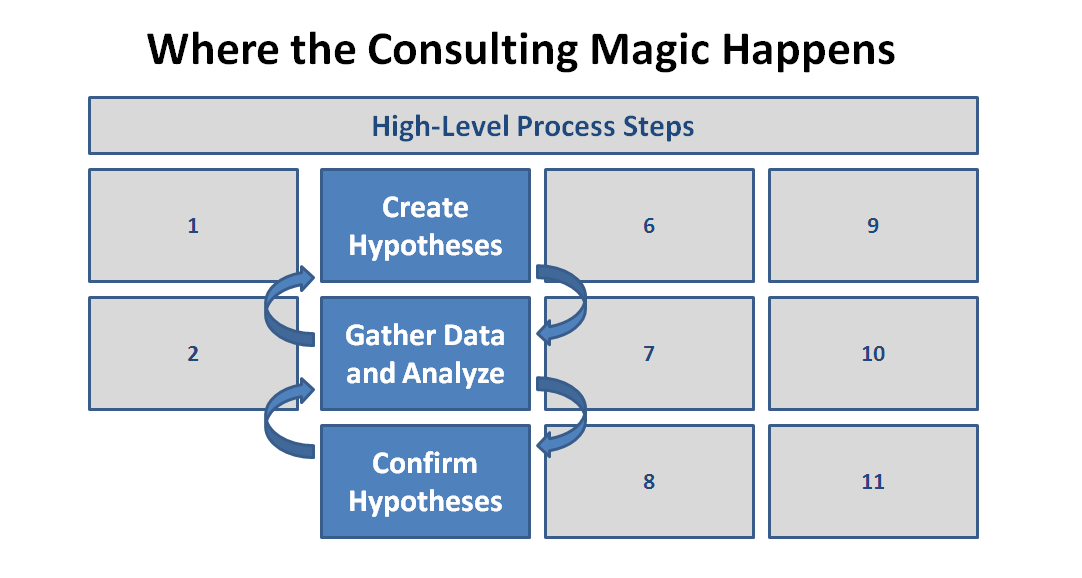Hypothe – what?
Yes, I know it sounds like jargon, but actually it’s part of the secret sauce of management consulting. It’s more than educated guessing; this is how consultants smartly break down complex or ambiguous problems, and quickly start driving towards an answer. At its heart is the scientific method – used for hundreds of years by scientists and thinkers to prove their ideas using evidence. Old school hat tip – Aristotle, Bacon, Descartes.
Hypotheses start early
For some, “hypothesis” is a word you last heard in science class. The concept is simple, but may seem a bit counter-intuitive when you put it into practice. In the generic project plan below, you can see that the hypothesis development happens early on. This typically looks like some best practices research, interviews with clients, and lots of whiteboard time. You put together some initial ideas (logical starting points, not just wild guesses), quickly eliminate the bogus leads and focus on the promising ones. Like a wildcatter, you dig where there you think there will be oil. This is a mix of science, experience, and art.

Think broadly about the problem
Consultants have the time (clients have day-jobs) and the authority (borrowed influence from their client executives) to cast a wide net for answers.
Often, the root causes of the problem sit elsewhere – in other functions, other business units, or even with suppliers. As groups get more specialized, they also get more silo-ed. Operational efficiency leads to enterprise-wide sub-optimization. Person A gets very efficient at her specific process, which creates downstream inefficiency for Person B somewhere else in the system.
In the example below, the client might believe ABC is the reason for the fall in market share, but in reality, it is a combination of other reasons that the client did not see (or want to admit). Let’s not mistake correlation with causation.
Treat hypotheses like suspects
Using the analogy of a TV detective from the 1970’s and 1980’s, Columbo would not rule out any suspects initially. He would survey the crime scene and start formulating some ideas on who the suspects were – based on eye-witness accounts, clues, and experience. Keep sleuthing for clues until he was confident that suspect was either guilty or not guilty.
Same thing here. The goal is to put together a list of hypotheses (“suspects” using the crime analogy) that are distinct and separate. Then start going down the list to figure out if they are guilty or not. Divvy up and conquer the hypothesis list with your team.
This approach can be unnerving
Sometimes, clients find this uncomfortable because they inadvertently assume that the consultants comes to the project with the answers already. So, when the team spends the first few weeks interviewing people and gathering data, it can feel like the project is going slowly or sideways. Here are a few things clients can do:
- Help get the data that the consultants need to confirm / disprove the hypotheses
- Share previous project work which tried to solve the problem and failed
- Fast-track the ideas which you believe don’t need more (over-kill) evidence
- Do not be shy; ask what the key hypotheses are
- Bring in the right people (even if in other departments)
You get more confident over tmie
The consulting team’s confidence in the solution typically ebbs and flows during the project. As there is more fact-finding and discovery, new hypotheses are created and eventually whittled down. By the end of the project, the team should be fairly confident in their answer and have the data and analysis to back-up their recommendations. As shown in the graphic below, there are lots of ups and downs, but confidence trends up.
Clients, give the consultants a little space
to take in the information and think deeply on the problem. A lot of the brain power is spent early in the project or during the proposal stage. Time well spent.
Oh Bill Gates. . .
In a famous story about Bill Gates, his mother was getting frustrated when he would not come to dinner or respond to her calls. She demanded, “What are you doing?”
“I am thinking, Mom. Have you ever tried thinking?“
– Bill Gates
